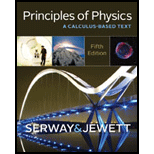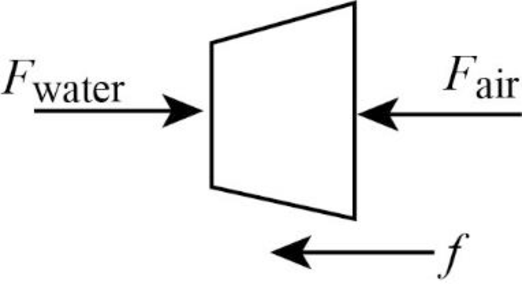
A village maintains a large tank with an open top, containing water for emergencies. The water can drain from the tank through a hose of diameter 6.60 cm. The hose ends with a nozzle of diameter 2.20 cm. A rubber stopper is inserted into the nozzle. The water level in the tank is kept 7.50 m above the nozzle. (a) Calculate the friction force exerted on the stopper by the nozzle. (b) The stopper is removed. What mass of water flows from the nozzle in 2.00 h? (c) Calculate the gauge pressure of the flowing water in the hose just behind the nozzle.
(a)
The friction force exerted on the stopper by the nozzle.
Answer to Problem 45P
The friction force exerted on the stopper by the nozzle is
Explanation of Solution
Take point 1 to be at the free surface of the water in the tank and point 2 to be inside the nozzle. Since the top of the tank is open to the atmosphere the pressure at point 1 will be equal to atmospheric pressure. Since the tank has large area compared to the nozzle, the speed of water at point 1 will be very small compared to that at point 2 according to continuity equation and can be considered to be zero. Also assume the position of the nozzle to be
Write the Bernoulli’s equation.
Here,
Substitute
The diagram of the different forces on the system is shown below.

In the diagram
The sum of the forces in the horizontal direction must be zero for the stopper.
Write the equilibrium condition for the stopper.
Here,
Write the expression for
Here,
Put the above equation in equation (III) and rewrite it for
Write the equation for pressure.
Here,
Rewrite the above equation for
Use equation (V) to write the expression for
Here,
Use equation (V) to write the expression for
Put the above two equations in equation (IV).
Write the equation for
Here,
Put equations (II) and (VII) in equation (VI).
Conclusion:
The value of
Substitute
Therefore, the friction force exerted on the stopper by the nozzle is
(b)
The mass of water that flows from the nozzle in
Answer to Problem 45P
The mass of water that flows from the nozzle in
Explanation of Solution
When the stopper is removed, point 2 is also at the atmospheric pressure.
Substitute
Write the equation for density of water.
Here,
Write the equation for volume of water.
Here,
Write the equation for the velocity of water at point 2.
Here,
Rewrite the above equation for
Put equation (IX) in the above equation.
Put equations (VII) and (XII) in equation (XI).
Put the above equation in equation (X) and rewrite it for
Conclusion:
Substitute
Therefore, the mass of water that flows from the nozzle in
(c)
The gauge pressure of the flowing water in the hose just behind the nozzle.
Answer to Problem 45P
The gauge pressure of the flowing water in the hose just behind the nozzle is
Explanation of Solution
Assume point 1 to be in the wide hose and point 2 to be just outside the nozzle.
Write the continuity equation of fluids.
Here,
Write the equation for
Here,
Write the equation for
Put the above two equations in equation (XIV) and rewrite it for
Take the vertical position of point 1 and point 2 to be zero.
Substitute
Conclusion:
Substitute
Substitute
Substitute
Therefore, the gauge pressure of the flowing water in the hose just behind the nozzle is
Want to see more full solutions like this?
Chapter 15 Solutions
Principles of Physics
Additional Science Textbook Solutions
Tutorials in Introductory Physics
Physical Universe
Life in the Universe (4th Edition)
The Physical Universe
The Cosmic Perspective (9th Edition)
- A large storage tank with an open top is filled to a height h0. The tank is punctured at a height h above the bottom of the tank (Fig. P15.39). Find an expression for how far from the tank the exiting stream lands. Figure P15.39arrow_forwardFigure P15.47 shows a stream of water in steady flow from a kitchen faucet. At the faucet, the diameter of the stream is 0.960 cm. The stream fills a 125-cm3 container in 16.3 s. Find the diameter of the stream 13.0 cm below the opening of the faucet. Figure P15.47arrow_forwardAn incompressible, nonviscous fluid is initially at rest in the vertical portion of the pipe shown in Figure P15.61a, where L = 2.00 m. When the valve is opened, the fluid flows into the horizontal section of the pipe. What is the fluids speed when all the fluid is in the horizontal section as shown in Figure P15.61b? Assume the cross-sectional area of the entire pipe is constant. Figure P15.61arrow_forward
- The gravitational force exerted on a solid object is 5.00 N. When the object is suspended from a spring scale and submerged in water, the scale reads 3.50 N (Fig. P15.24). Find the density of the object. Figure P15.24 Problems 24 and 25.arrow_forwardA U-tube open at both ends is partially filled with water (Fig. P15.67a). Oil having a density 750 kg/m3 is then poured into the right arm and forms a column L = 5.00 cm high (Fig. P15.67b). (a) Determine the difference h in the heights of the two liquid surfaces. (b) The right arm is then shielded from any air motion while air is blown across the top of the left arm until the surfaces of the two liquids are at the same height (Fig. P15.67c). Determine the speed of the air being blown across the left arm. Take the density of air as constant at 1.20 kg/m3.arrow_forwardReview. The tank in Figure P15.13 is filled with water of depth d. At the bottom of one sidewall is a rectangular hatch of height h and width w that is hinged at the top of the hatch. (a) Determine the magnitude of the force the water exerts on the hatch. (b) Find the magnitude of the torque exerted by die water about die hinges.arrow_forward
- A horizontal pipe 10.0 cm in diameter has a smooth reduction to a pipe 5.00 cm in diameter. If the pressure of the water in the larger pipe is 8.00 104 Pa and the pressure in the smaller pipe is 6.00 104 Pa, at what rate does water flow through the pipes?arrow_forwardA village maintains a large tank with ail open top, containing water for emergencies. The water can drain from the tank through a hose of diameter 6.60 cm. The hose ends with a nozzle of diameter 2.20 cm. A rubber stopper is inserted into the nozzle. The water level in the lank is kept 7.50 m above the nozzle. (a) Calculate the friction force exerted on the stopper by the nozzle. (b) The stopper is removed. What mass of water flows from the nozzle in 2.00 h? (c) Calculate the gauge pressure of the flowing water in the hose just behind the nozzle.arrow_forwardA 10.0-kg block of metal measuring 12.0 cm by 10.0 cm by 10.0 cm is suspended from a scale and immersed in water as shown in Figure P15.24b. The 12.0-cm dimension is vertical, and the top of the block is 5.00 cm below the surface of the water. (a) What are the magnitudes of the forces acting on the top and on the bottom of the block due to the surrounding water? (b) What is the reading of the spring scale? (c) Show that the buoyant force equals the difference between the forces at the top and bottom of the block.arrow_forward
- Fluid originally flows through a tube at a rate of 100 cm3/s. To illustrate the sensitivity of flow rate to various factors, calculate be new flow rate for following changes with all other factors remaining the same as in original conditions. (a) Pressure difference increases by a factor of 1.50. (b) A new fluid wit 3.00 times greater viscosity is substituted. (c) The tube is replaced by one having 4.00 times the length. (d) Another tube used with a 0.100 times the original. (e) Yet another tube is substituted with a radius 0.100 times the original and half length, and pressure difference is increased by factor of 1.50.arrow_forwardMercury is poured into a U-tube as shown in Figure P15.17a. The left arm of the tube has cross-sectional area A1 of 10.0 cm2, and the right arm has a cross-sectional area A2 of 5.00 cm2. One hundred grams of water are then poured into the right arm as shown in Figure P15.17b. (a) Determine the length of the water column in the right arm of the U-tube. (b) Given that the density of mercury is 13.6 g/cm3, what distance h does the mercury rise in the left arm?arrow_forwardWater is moving at a velocity of 2.00 m/s through a hose with internal diameter of 1.60 cm. (a) What is the flow rate in liters per second? (b) The fluid velocity in this hose's nozzle is 15.0 m/s. What is the nozzle's inside diameter?arrow_forward
 Physics for Scientists and Engineers, Technology ...PhysicsISBN:9781305116399Author:Raymond A. Serway, John W. JewettPublisher:Cengage Learning
Physics for Scientists and Engineers, Technology ...PhysicsISBN:9781305116399Author:Raymond A. Serway, John W. JewettPublisher:Cengage Learning Principles of Physics: A Calculus-Based TextPhysicsISBN:9781133104261Author:Raymond A. Serway, John W. JewettPublisher:Cengage Learning
Principles of Physics: A Calculus-Based TextPhysicsISBN:9781133104261Author:Raymond A. Serway, John W. JewettPublisher:Cengage Learning Physics for Scientists and Engineers: Foundations...PhysicsISBN:9781133939146Author:Katz, Debora M.Publisher:Cengage Learning
Physics for Scientists and Engineers: Foundations...PhysicsISBN:9781133939146Author:Katz, Debora M.Publisher:Cengage Learning College PhysicsPhysicsISBN:9781938168000Author:Paul Peter Urone, Roger HinrichsPublisher:OpenStax College
College PhysicsPhysicsISBN:9781938168000Author:Paul Peter Urone, Roger HinrichsPublisher:OpenStax College University Physics Volume 1PhysicsISBN:9781938168277Author:William Moebs, Samuel J. Ling, Jeff SannyPublisher:OpenStax - Rice University
University Physics Volume 1PhysicsISBN:9781938168277Author:William Moebs, Samuel J. Ling, Jeff SannyPublisher:OpenStax - Rice University Physics for Scientists and EngineersPhysicsISBN:9781337553278Author:Raymond A. Serway, John W. JewettPublisher:Cengage Learning
Physics for Scientists and EngineersPhysicsISBN:9781337553278Author:Raymond A. Serway, John W. JewettPublisher:Cengage Learning





